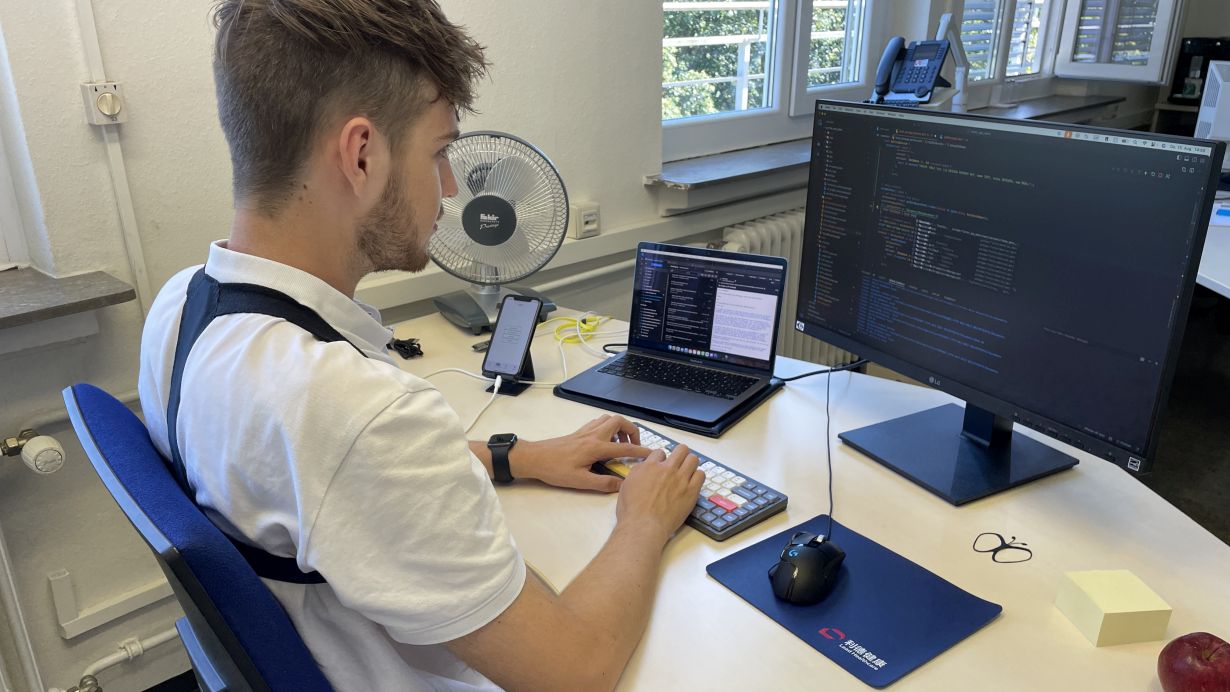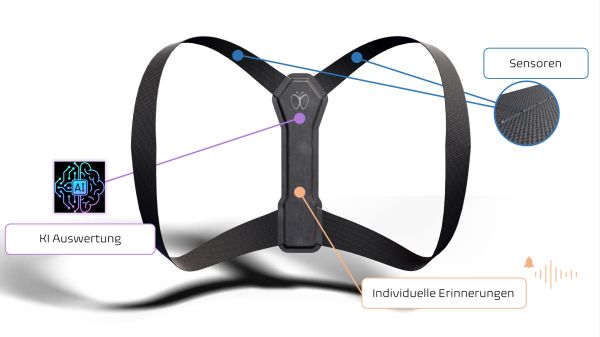
Back pain is one of the main causes of everyday afflictions and sick leave in the western world. This is often due to physical inactivity in a sedentary office environment, aggravated by a lack of compensatory exercise such as sports and gymnastics. StraightUp, a spin-off founded by three graduates from Karlsruhe Institute of Technology (KIT), aims at fighting back pain in the long term and sustainably with an innovative idea. To this end, they have developed a wearable textile product that measures the shoulder position and the inclination of the back using woven-in elastic wires and a suitable sensing system, providing haptic feedback to ensure a lasting posture optimization.
Current postural stabilization systems solely hold the back in place, which considerably restricts the user's mobility in the long term. Other approaches with built-in inclination sensors, which trigger a vibration stimulus when the body leans forward, are disadvantageous in that many everyday and sports activities are carried out in a forward-leaning position, therefore triggering false vibration stimuli.
New Approach Using an Elastic Metal Alloy and Leveraging AI
The StraightUp spin-off is tackling this problem with an innovative idea. Erik Vautrin, Marcus Hamann-Schroer, and Jan Bartenbach, three KIT graduates, teamed up with physiotherapist Tobias Baierle to develop a visionary textile wearable, which measures the shoulder position and the inclination of the back using elastic wires incorporated into the fabric. Using the data obtained this way and relying on a woven-in chip controlled by artificial intelligence (AI), the system generates haptic feedback in the form of vibrations that encourage the users to correct their posture. A conductive super-elastic metal alloy, which adapts perfectly to the movements of the person wearing the product, enabled the use of this sensing system. "The haptic feedback teaches the body to maintain a healthier posture by itself so that a long-term improvement can be achieved. The feedback system promotes active stabilization of the shoulder blades and corrects the posture of the spine," explains Baierle. The wearable can we worn both in everyday life and during leisure and sports activities.

relies on sensors, AI, and haptic feedback. (Photo: StraightUp)
Further Steps on the Path to Establishing the Spin-off and Achieving Commercial Viability
The team currently cooperates with the German Institutes of Textile and Fiber Research to enable the best possible integration of the sensing system into the wearable. "This partnership is a big step towards commercial viability of the wearable," explains Vautrin. Later this year, optimization tests involving doctors, physiotherapists, and other experts will be conducted. The aim is to test the enhanced product on potential customers by the end of the year.
Support for Founders at KIT
The three founders of StraightUp got to know each other in the "Microsystem product design for young entrepreneurs" course at KIT. "During the course, we learned the basics of developing and implementing a product idea. We also benefited from being taught some practical things such as how to write a business plan," says Bartenbach. A lecturer made the young team acquainted with physiotherapist Baierle.
On their journey so far, the founders have made use of the support options available at KIT. These include the KIT Founders Forge and other services offered by KIT's Innovation and Relations Management (IRM) business unit. With the support of IRM, the StraightUp team successfully acquired funds through an EXIST start-up grant to prepare and finance the early stages of their forthcoming spin-off. "The StraightUp team convinced us right from the start by the expertise of the individual persons and their interaction with each other," says Dr. Rolf Blattner, Business Development Manager at IRM.
More information on StraightUp
Being "The Research University in the Helmholtz Association", KIT creates and imparts knowledge for the society and the environment. It is the objective to make significant contributions to the global challenges in the fields of energy, mobility, and information. For this, about 10,000 employees cooperate in a broad range of disciplines in natural sciences, engineering sciences, economics, and the humanities and social sciences. KIT prepares its 22,800 students for responsible tasks in society, industry, and science by offering research-based study programs. Innovation efforts at KIT build a bridge between important scientific findings and their application for the benefit of society, economic prosperity, and the preservation of our natural basis of life. KIT is one of the German universities of excellence.






